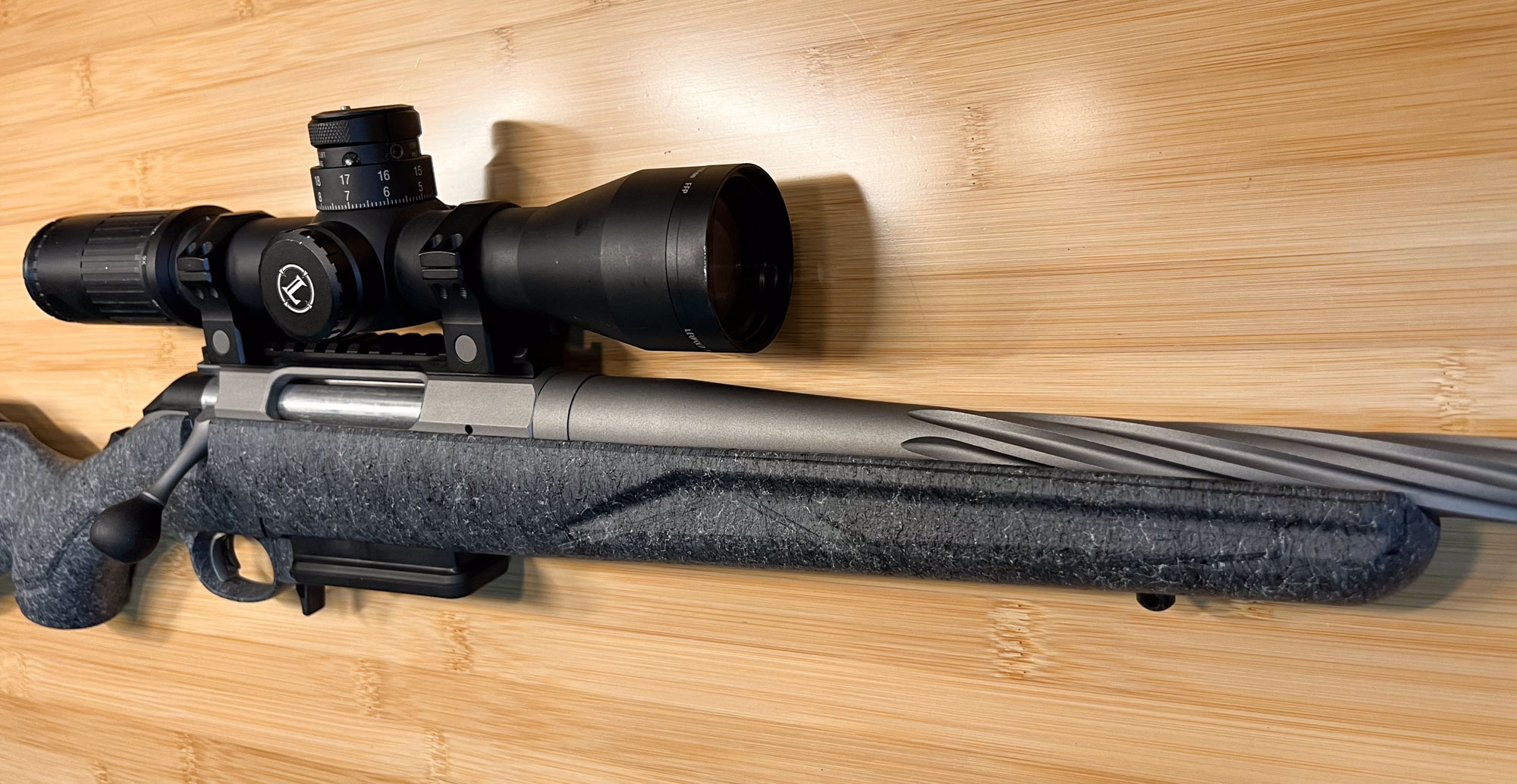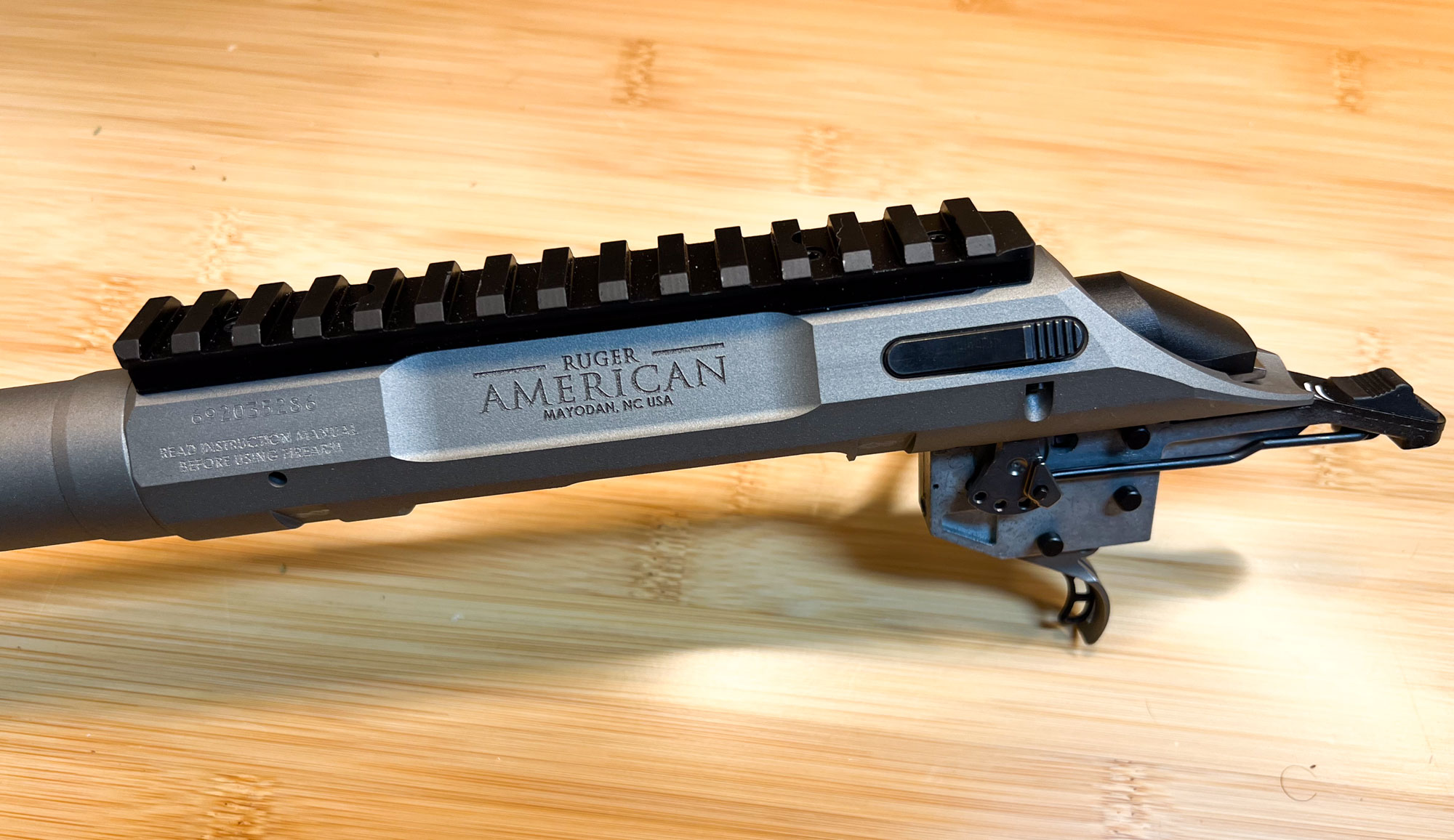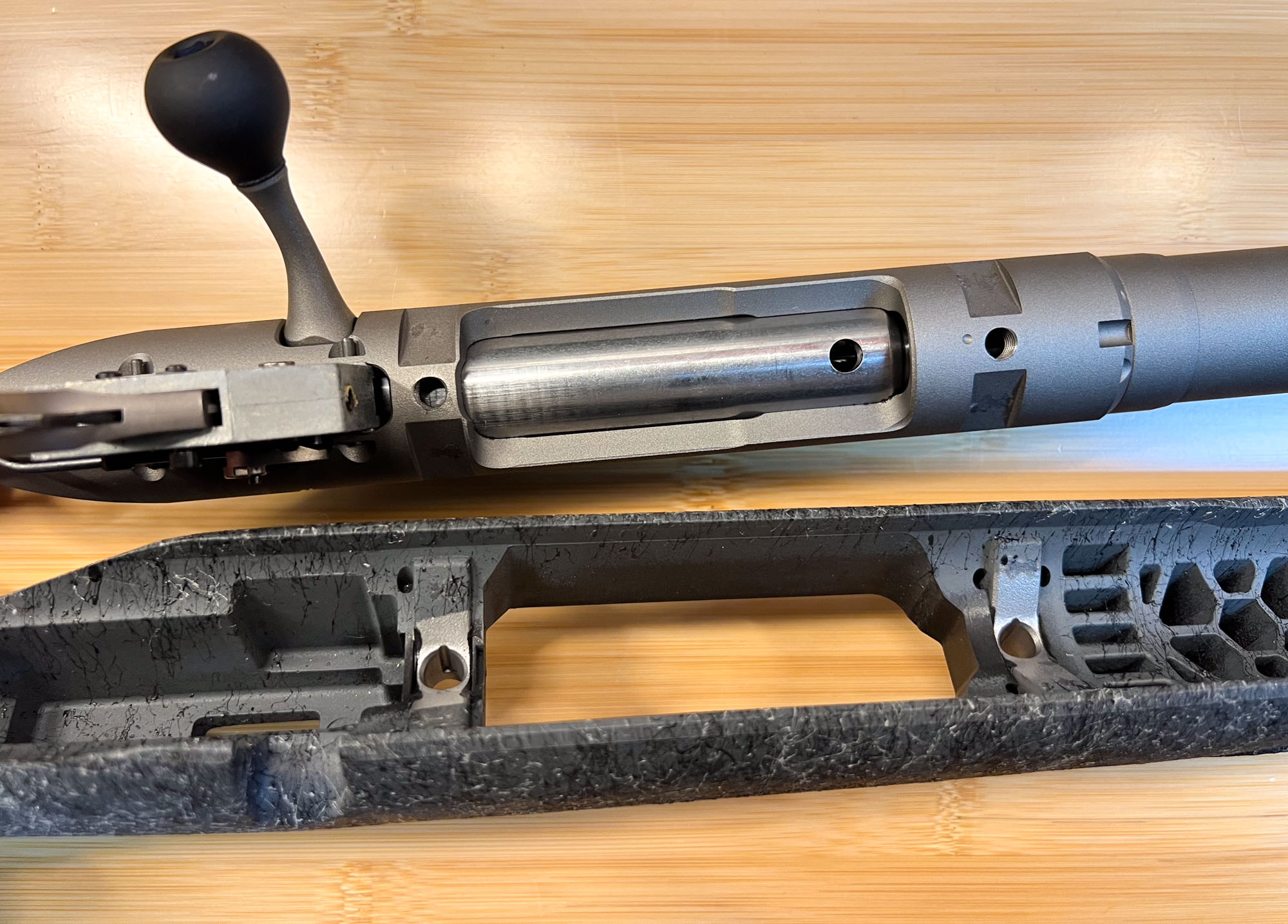We may earn revenue from the products available on this page and participate in affiliate programs. Learn More ›
I’ve spent a lot of time with the new Ruger American Rifle Generation II over the last few weeks, hunting with it in the field and wringing it out at the range, and am confident that Ruger has another success on their hands.
This rifle is a significant update over the company’s popular first-gen Ruger American Rifle, which set a new high-water mark for affordable performance when it was introduced in 2010.
This new iteration features improved functionality, an innovative modular stock, and better aesthetics for not much more money. The Generation II lists for about $130 more than the original Ruger American, putting it squarely in the mid-priced rifle segment.
Ruger American Rifle Generation II Specs
- Caliber: 6.5 Creedmoor (tested)
- Other Available Calibers: 308 Win., 7mm/08, 450 Bushmaster, 204 Ruger, 223 Rem.
- Capacity: 3+1, detachable polymer box magazine
- Stock: Gray splatter, modular
- Barrel: 20 inches, fluted, 1:8 twist, threaded 5/8-24 with radial muzzle brake
- Finish: Gun Metal Gray Cerakote
- Length: 41.25 inches (depending on length of pull)
- Length of Pull: 12 to 13.75 inches
- Weight: 6 pounds, 7.8 ounces (measured, with empty magazine)
- Trigger: User adjustable, 4 pounds 2 ounces (measured)
- Safety: Three position, ambidextrous
- Price: $729
What’s New with The Ruger American Rifle Generation II
This rifle isn’t a mere line extension, but a legitimate reconfiguration of the platform. While it does share some elements with the first-generation Ruger American, there is much that is different.
Ruger American Gen II Major Upgrades
- Ambidextrous three-position safety
- Configurable modular stock
- Improved aesthetics
These are the three biggest areas of differentiation between the Generation II and Generation I Ruger American.

Three-Position Safety
While there’s nothing wrong with a classic two-position safety, you might not realize what you’re missing if you haven’t carried and shot a rifle with a three-position safety. Having the bolt of your rifle locked in place while the gun is on safe is a valuable feature when traversing terrain. It offers peace of mind that your bolt won’t inadvertently lift open because it snagged on brush or got caught on the strap of your pack.
The middle position of the safety mechanism unlocks the bolt and allows you to unload or confirm the status of the rifle without needing to place it on “fire.”
Ruger centered the safety just behind the tang, so it is as easy to operate with either hand. The safety moves easily through the three positions without much pressure required to manipulate it.

Modular Stock
The rear swivel stud on the rifle is tucked into a recess on the toe of the stock at a 45-degree angle. This design makes the stud less obtrusive, which is nice, but it performs a more important function beyond securing the lower half of your sling.
Unscrewing the stud allows you to take the butt of the stock apart and swap out the spacers that control the length of pull and comb height.
From the factory, the rifle comes with a 13.75-inch length of pull, the standard size for an adult. But you can purchase a spacer kit that lets you reduce the LOP to 12 inches, for younger shooters or those with smaller builds. Similarly, you can swap cheek pieces to raise the height of the comb if desired.
Ruger also offers a weight kit to tune the balance and heft of the rifle. With an empty magazine, mine tipped the scales just under 6.5 pounds, which is a handy weight for ease of carry. But with the growing use of suppressors, which tend to make rifles muzzle heavy and impede smooth handling, it can be preferable to add some weight to the butt to even things out. Extra weight is also helpful for mitigating felt recoil. Ruger says the kit can add up to 1.6 pounds to the butt stock.
Ruger American Rifle Generation II Disassembly
Another modular element on the stock is the mag well, which can be swapped to accommodate different types of magazines. Mine came with a polymer AICS-pattern 3-round magazine, which is standard on this model. Other iterations of the Ruger American Gen II will take AR-style, Mini Thirty, and flush magazines.
Removing the magazine well and disassembling the rifle involve the same process. There’s a 3/16-inch hex-head fastener in front of the mag well, and another tucked in behind the magazine release latch.
The rear fastener tucked behind the mag latch is a pain to get to and requires a round-head hex driver. So, if you don’t have one of those in your tool box you’re going to want to add it to your collection if you get a Gen II Ruger American Rifle.
Even if you don’t intend to swap magazine systems on the rifle, it’s important to be able to access the innards of the firearm as that’s how you adjust the trigger-pull weight and perform a deep cleaning on the gun.

Improved Aesthetics
While you can’t argue about the performance of the original Ruger American Rifle, especially considering its price, no one ever accused it of being a looker. It has a basic, utilitarian design typical of an entry-level rifle.
The Gen II rifle has greater aspirations. The lines of the stock are much more interesting than the original. It has many sculpted, but practical, contours molded into the fore-end, grip, and butt.
Ruger finished the stock in a spider-web style platter finish that adds strands of black and lighter gray to the base battleship gray of the stock.
The metalwork is upgraded too. The 20-inch barrel is cut with deep spiral flutes that trim some weight from the front of the gun, but also look sharp. And the Ruger American Rifle Generation II’s metal—specifically the barrel, receiver, muzzle brake, and bolt handle—is finished in an attractive gray Cerakote.
Overall, the rifle has a racy, rugged look that elevates it above the first generation.

Running the Ruger American Rifle Generation II
One thing I like about this new Ruger is how it builds upon the successful foundation of the original while augmenting the feature set. It checks an impressive number of boxes for the price.
As with most things in life, however, you get what you pay for, and the Ruger American Rifle Generation II is no exception. This is most evident in the rifle’s handling and ergonomics.
Now don’t get me wrong—the rifle runs well and is a very good value. There’s no head-scratching element in its design. Everything in its construction serves a useful purpose and does what it is supposed to do.
But it is still a $700 rifle and isn’t as refined as its pricier competition. For instance, the magazine fits snuggly in the magazine well and doesn’t drop free of its own accord when the release lever is actuated. You need to give it a light tug to pull it free. And when inserting the magazine, it takes a bit of fiddling to get it started—it doesn’t effortlessly slide into place, though once in it does seat with a positive click.
Three-Lug Action
The new Ruger American Rifle uses the same three-lug action as the original. Dual cocking ramps help mitigate the effort required to run the bolt through its 70 degrees of travel when working the action, which was one of the most notable design innovations of the platform.
The full-diameter bolt body keeps bolt chatter to a minimum when moving the bolt up and down the receiver for reliable, positive feeding.
The bolt head contains a Sako-style extractor in one of the lugs and a plunger-style ejector. In the couple hundred rounds I ran through the rifle I had no issues with either.
But the rifle does take some effort to cycle. It doesn’t go into battery as easily as some other three-lug actions and the bolt has a slightly clunky feel. It isn’t that noticeable when running the rifle hard under field conditions but is more apparent with deliberate shooting from a bench.

User-Adjustable Trigger
I’ll be the first to admit that I’m a bit spoiled by my rifle triggers. If a rifle of mine doesn’t come with a premium trigger it tends to be the first component I upgrade.
From the factory, the trigger on my Ruger American Rifle Generation II had a pull weight of 4.25 pounds. A couple decades ago that would have been deemed more than acceptable. By today’s standards, though, it is on the heavy side for a bolt-action. On top of that, the trigger has a fair bit of creep prior to the break. The movement is smooth—there’s no grit in the trigger pull—but the creep is noticeable, and I found it distracting.
To get to the trigger’s pull-weight adjustment screw you need to remove the action from the stock, per the process I described above. The 3/32-inch Allen head adjustment screw is located on the front of the trigger housing and is secured in place with some type of thread lock.
After turning the screw counterclockwise to lessen the pull, the trigger on mine broke at 3 pounds, 15 ounces, which was as light as I could get it to go. Screwing it in deeper, the trigger maxed out at 4 pounds, 6 ounces, so there wasn’t really a lot of adjustability in the trigger—about half a pound—at least on mine.
Stock and Bolt Interface
The contours and texturing of the stock provide the shooter with ample grip and control of the rifle while shooting from practical field positions. The round bolt knob is smooth but generously sized, also giving excellent control. The knob is secured in place with a 5/16-24-inch fastener and can be easily replaced with an aftermarket design, if desired.
Handling and Balance
This level of control coupled with the rifle’s good balance make for pleasant shooting. Whatever quirks the rifle exhibits at the bench fade into the background when running the gun from the shoulder.
Pulling up on a target, flicking the safety off, breaking the shot, and running the bolt all feel fluid and intuitive. The only downside I experienced was that I couldn’t single load rounds into the action after running the magazine dry. When you toss a single round into the rifle the tip of the bullet jams against the shoulder of the barrel, so you need to coax the cartridge into place with your fingers if you want to load one this way.

Ruger American Rifle Generation II Accuracy
I remember being stunned by the accuracy of the original Ruger American Rifle, so my expectations for the Gen II were pretty high.
The rifle didn’t disappoint. I put 19 groups for record down-range, shooting seven different factory loads through the gun.
One load shot very poorly—and in fact is from a lot of ammo I’ve officially retired from my testing protocol because no gun of mine shoots it well. Discounting those three dog-puke groups—all of which were between 1.76 and 1.78 inches, so at least it is consistent—the rifle averaged 1.061 inches for five-shot groups.
Sub-MOA Performance
Of the 19 groups, nine were sub-MOA, and came from four different loads. They included Federal’s new 140-grain OTM Center Strike, Sig Sauer’s 130-grain Elite Hunter Controlled Expansion, Freedom Munitions’ 140-grain BTHP Match, and Federal’s 140-grain Fusion.
This last load deserves special mention. The two back-to-back five-shot groups I put through the rifle with it measured .747 and .764 inches, which is excellent for a bonded soft-point hunting bullet.
Through the Ruger’s 20-inch barrel the 10 shots averaged 2547 fps, with an extreme spread of 48.6 fps, and an SD of 16.3, which is about as good as mass-produced factory ammo gets.
(I measured the velocities of this and the other loads with Garmin’s superlative Xero C1 Pro chronograph.)
That speed included whatever boost my Gunwerks 6IX+Ti gave the rounds. While the rifle ships with an effective radial muzzle break, I ditched it in favor of a suppressor after the first few groups to save the pounding on my ears.
Mounting Optics
The Ruger American Rifle Generation II comes with a Picatinny rail that runs along the full length of the receiver. I mounted one of my go-to scopes for this evaluation, a Leupold Mark 6 3-18x44mm FFP, which goes well with the rifle, particularly when assessing accuracy and long-range shooting potential.

Hunting with the Ruger American Rifle Generation II
A few weeks ago I got a chance to take the rifle hunting for a week in Texas, chasing an elusive Carmen whitetail, which is a diminutive critter, similar to the better-known Coues.
That included lots of hours of stalking through the rugged broken country of West Texas the Carmen call home. I racked up miles on foot and in trucks scrambling over jagged shelves of granite and weaving through thickets of cat’s claw and cholla in what ultimate proved to be a fruitless quest for a buck—though it did provide an illuminating look at the Gen II’s charms.
The rifle was right at home on this hunt. Easy to carry. Impervious to the dings and scratches doled out by hard use. And capable of making a long shot, should the opportunity arise.
That experience, as much as my extensive range time, solidified my opinion on the utility and value of this rifle as a hunting tool.

Pros and Cons of the Ruger American Rifle Generation II
I’ve touched on some of the highs and lows of the rifle in this review, but to recap:
Pros
- Excellent accuracy
- Modular design
- Upgraded looks
- Rugged
- Very good value
Cons
- Heavy trigger
- Some unrefined ergonomics
Final Thoughts on the Ruger American Rifle Generation II
The original Ruger American Rifle has been around for 13 years now, so it makes sense that Ruger has decided on a refresh.
I’m glad to see they went much deeper than a mere line extension. The Generation II lives up to its name, taking the well-regarded Ruger American Rifle to new heights, and giving it meaningful upgrades and a new lease on life as a solid mid-priced rifle.
